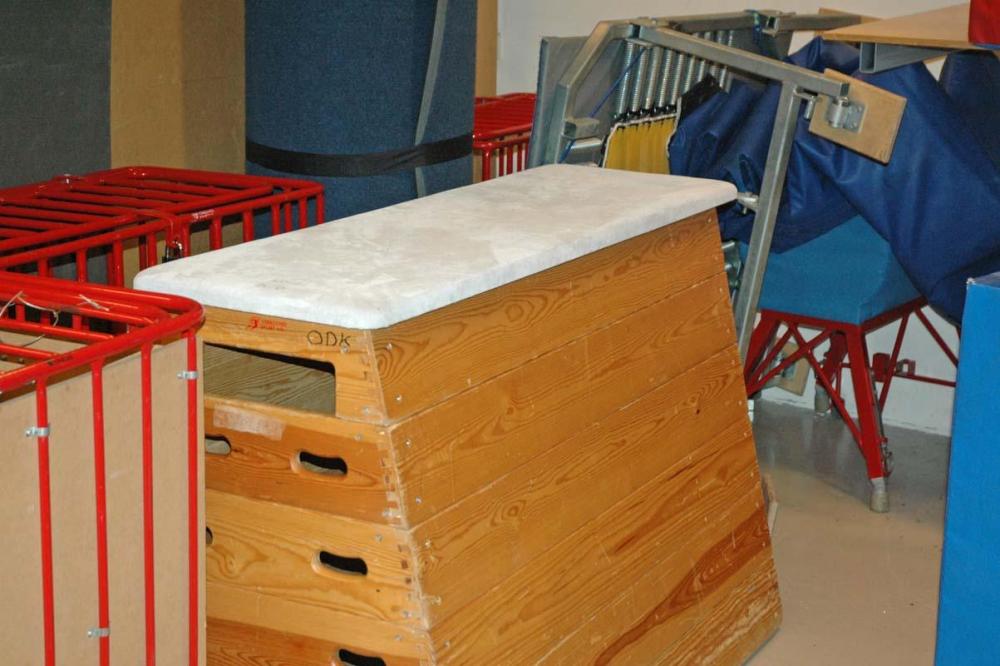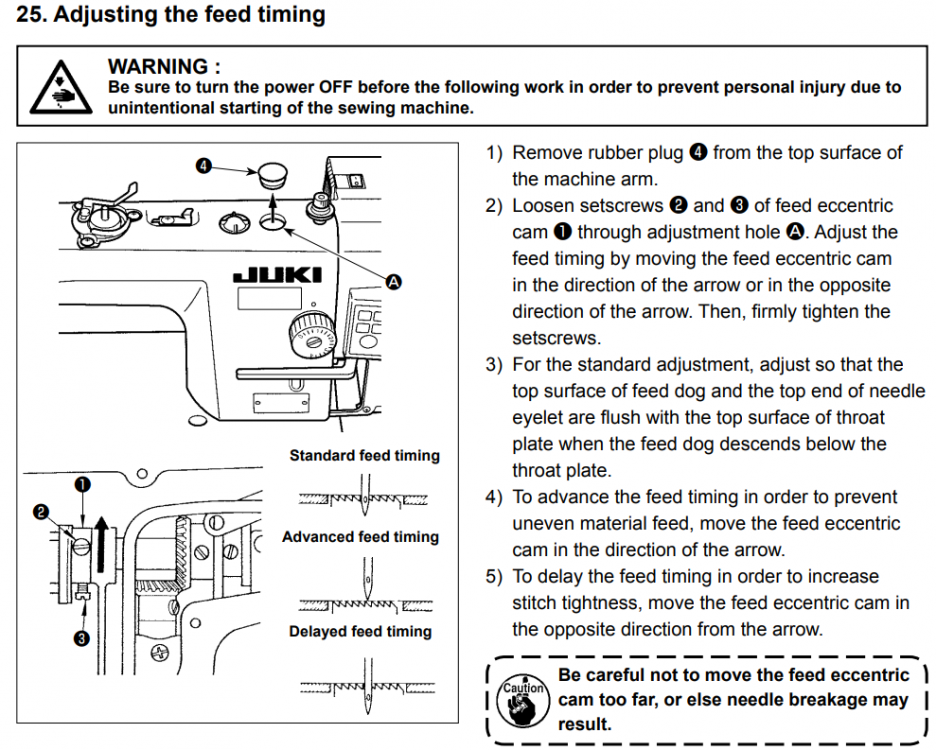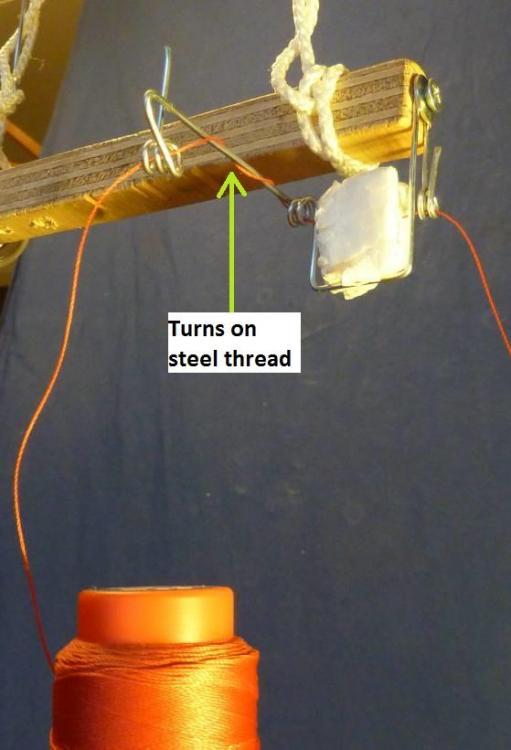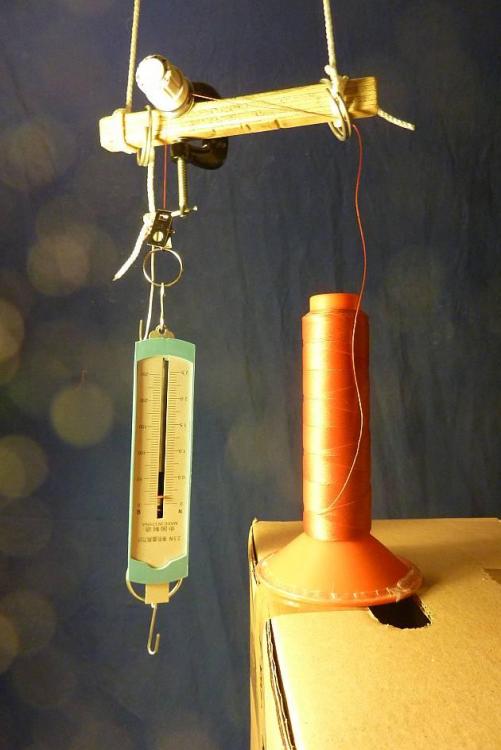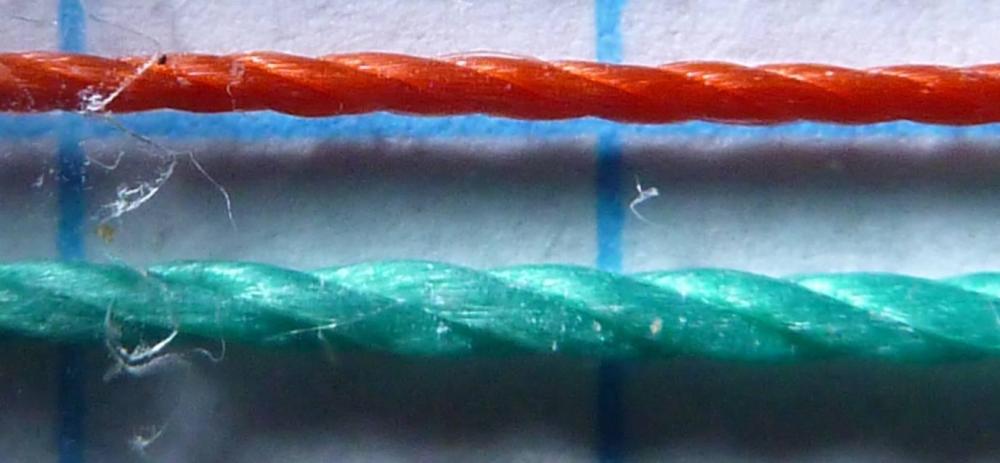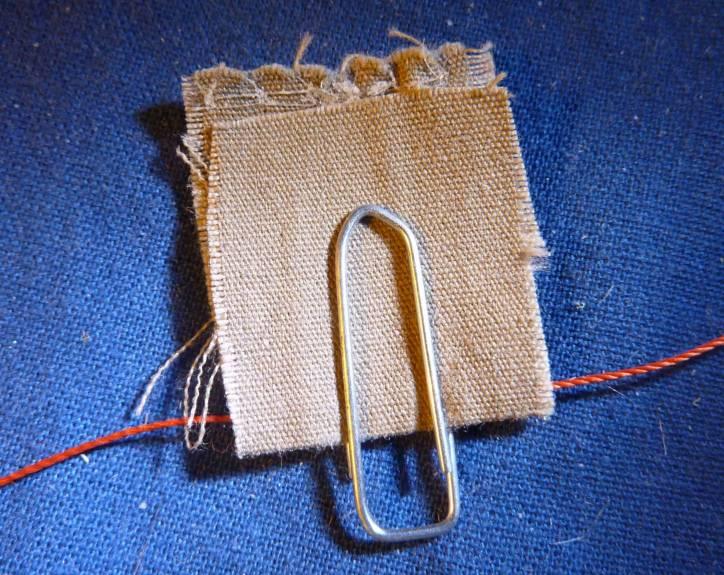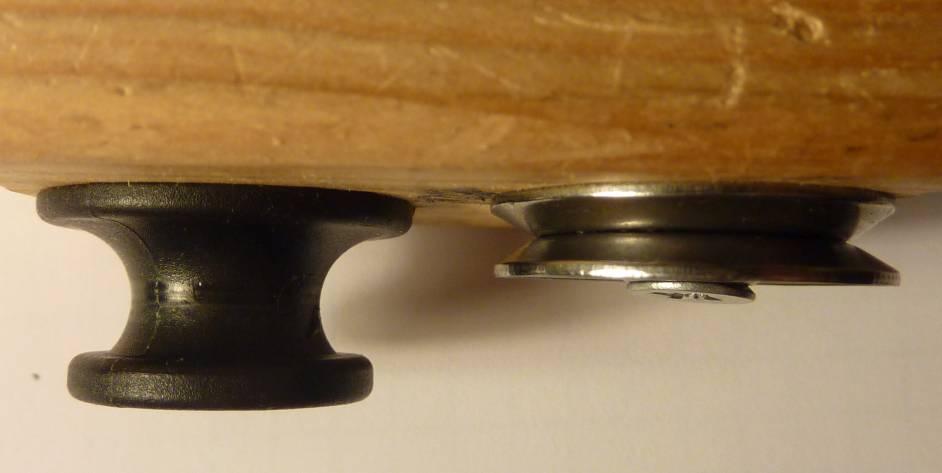
Gymnast
Members-
Posts
287 -
Joined
-
Last visited
Content Type
Profiles
Forums
Events
Blogs
Gallery
Everything posted by Gymnast
-
In another forum, a guy using this black bonded nylon thread ended at a similar solution to have the thread roll off the spool and for more sewing machines. But according to him, he got problems with hook catching the tread, if he let the thread come off the end of the spool. I have never heard thread twisting should be able to cause such problems. Another guy reported kinks on needle thread in the shuttle area. Up to now I mainly have read about problems with kinks in the thread pass before main tensioner. What kind of problems have you seen, that should be due to thread twisting?
-
Covid-19 and disinfection of leather surfaces
Gymnast replied to Gymnast's topic in How Do I Do That?
When you search google on the subject of UV-light and Corona, at lot is going on right now. Disinfection by UV-light is not new. I know UV-light has been used for disinfection of packing materials for milk and juice in the machines just before the liquids are filled in and the cartoon is packed. It has been like that for at least 20 years. This technology is already in use many other places, but of cause now with Covid-19 at lot more places are relevant for this technology. Yes, ventilation of rooms are also a matter of consern as well as how people may come and exit the room. -
Covid-19 and disinfection of leather surfaces
Gymnast replied to Gymnast's topic in How Do I Do That?
Thank you very much for all the response. Just for the record. The problem in Denmark is quite low at the moment with 18 in hospital out of 5.8 mill citicens. Occationally we do have local areas with problems. Most surfaces we need to disinfect is covers of mats made of vinyl (PVC). Then we got some leather. I think most gymnastics clubs in Denmark will be using ordinary soap or general purpose cleaning products. This is one solution proposed by video(speaker in danish): https://www.facebook.com/PEredskaber/videos/3572701646131449/?__tn__=%2Cd%2CP-R&eid=ARC1T5L9r0qLl8aHqRsStBkEFrX2YncBTMW1itonleKpWKIpO7dGHoihAs_l_zUkGN9jktUaDZC7D586 We have some soft mats with a stretch knitted fabric (jersey) with viscose in it on the top of the mat. No solution has been found here and I think most will accept that we cannot clean them. Then we have to remove all common yoga mats. People need to have their own mat. The virus can go into the mats in ways, that we cannot clean or kill in an efficient way. Soap is effective on virus, but is is hard to use on hands without a sink. Therefore alcohol gel is used for hand disinfection only and it is used quite often with many dispensers around. We got no requirements on masks. This is not a political issue here. Scientists in Denmark do not find sufficient evidence for the use of masks, but some debate is going on among them. But it is demanded in some areas like public transport. Coaches may deside to use it, because they will touch and get close to many gymnasts. We also need to record who is there. UV-light could be a very interesting way to solve the problem. However we do know, that UV-light do affect life time of materials like PVC. We know, that we should not use these mats too much in the sun. But we need to know what the limits are, because it may not be any high dosis we need. This is a robot with UV-light moving around at its own (but of cause controlled) in a danish hospital (just for the picture): https://www.tv2fyn.dk/assens/frimaerkesamler-kan-jeg-bruge-uv-lys-til-desinficere-overflader . I saw a company selling UV-lamps saying, that everything was sold out now, so their might be delivery problems. -
In Denmark sports associations got demands for the comming season to disinfect common surfaces between each class of training. We have got some gymnastic equipment with some leather covers. I have been informed, that substances such as alcohol should be bad for leather. What do you suggest to use? Edit: This is one equipment:
-
A normal sewing machine have a hard point in the sewing cycle, when the needle is on its way up and the eye is in the middle of the fabric. Then the friction to the thread is high from needle and fabric. At the same time the hook pulls down the thread, and the local thread tension to do this can be very high. With a needle too small it can cause the machine to stop or the thread to be damaged. I think this is taken into account, when you use tables from internet, that suggest needle sizes for threads. But this patcher is different, because the needle bar movement is controlled by a cam. The needle remains down with the needle eye below the fabric while the hook pulls down the thread. Therefore this machine might be able to handle a thicker thread for the same needle size that you normally will see for other machines. I link to this youtube video from a guy, that expects to use a V207 thread with a size 22 needle. https://youtu.be/Vv9eZbRR2z8
-
I made a collection of nine videos from youtube on the topic of speed control. You may find it insteresting. https://www.youtube.com/playlist?list=PLhBGyDo4tov8XSL24b3eiAsGBhlPJA2SF You may just skip a video if you do not find it interesting. I have got a Bernina 910 domestic sewing machine, that I occationaly use for some garment. But I do not like the speed control, because when I press slowly down the pedal, I do not know when it will start sew, and suddently it starts. Some of my other machines makes some hum noise before it starts, and it is actually nice, because then you are prepared for when the sewing starts.
-
Walking ft. comp. feed - when & why?
Gymnast replied to SouthernCross's topic in Leather Sewing Machines
A Singer 201 is compareable to a Singer 15 in performance. This is a video of a modified Singer 201 sewing leather: https://youtu.be/HIDuHjMRFWg As the video points out and show, the feed dogs leave marks on the surface of the leather. A combined feed machine will leave no or mush less visible marks on the leather surfaces. Furthermore this shown 201 have quite a few modifications, and may not take this kind of work for much time before being worn out. But it is possible for some limited projects and with limited finish quality. The modifications here include speed reducer, tension spring, presser foot with thread notch and advanced timing of feed. I do not think, that an unmodified Singer 15-91 will get you sufficient punching power and low speed performance, because the motor is quite weak and gearing is for high speed. For upholstery you can find workers that like the drop feed machines. But most upholstery workers use walking foot machines too. This is an example of this: -
Well when nobody else responded I just like to guess a little based on your information. I think in some way the stitch lever position was changed by the impact your machine had on to the road. The correct range was 0 mm to 6 mm width, before. Now it have in some way changed to -2 to 4 mm. I guess the dial with lever outside got some lock screw on to the shaft into the machine. Inside the machine I guess there might be some other kind of lever attached to this shaft with one or two lock screws. So I guess that one of these levers have got turned a bit on this shaft by the impact. You have got another lever or dial to fix the needle position from left to right. How much are you able to move the needle using this lever?
-
Some sewers do light leatherwork on domestic machines or industrial machines for garment with dropfeed. I found this information about feed timing from JUKI on more of their industrial machines for garment: So they recommend an advance in feed timing in order to reduce variations in stitch length. A reason might be that the thread tension is applied and stitch is formed after the stroke of the feed dog finished. Therefore thread tension do not work against the feed.What is new to me is, that JUKI propose a delay in feed timing to increase stitch tightness. In this link it is reported, that you can reduce seam pucker by retarding feed timing:Link to book, Joining textilesI think it can be so, that with delayed feed timing, the feed is part of forming the stitch and makes some of the local thread tension to do so. Therefore less thread tension is needed from the tensioners. The result is that you can reduce seam pucker. But with heavier fabrics or more firm fabrics seam pucker will never be a problem and therefore it can be better to advance timing to improve feed dog traction with such fabrics.
-
I just noticed this video from 2016 with a presser food designed with this thread notch. So I am lucky to not be the first one with this idea. This food seems to be on a high shank straight stitch drop foot machine: I just noticed, that this is a needle feed machines, so therefor the presser foot design is different. But the presser foot do have a remarkable long thread slid to the back near the hinge of the foot.
-
What is the Consew 206 of straight stitch machines?
Gymnast replied to ensitmike's topic in Leather Sewing Machines
I agree, that this is the main problem for a bottom feed machine compared to a walking foot machine. But I think, that it is not only the presser foot, that make the drag on top. Another reason for the drag on the top is the needle thread tension combined with the presser foot. A modified presser foot can reduce this part of the problem significantly as explained in the video: https://youtu.be/rBIulDuhDDs -
Yes, I agree with you, but it may be because I am an engineer too. Perhaps it just work for some of us. I did start this other thread about the subject in July: And made this little video about it: https://youtu.be/PAUJ1cVJEmA
- 24 replies
-
- thread tension gauge.
- thread tensioner
-
(and 3 more)
Tagged with:
-
I noticed that the patcher sewing machines got a special movement of the needle bar compared to most other sewing machines. This is a video of the Chinese patcher sewing in some transparent fabric. Make note of the screw that fasten the needle in top of the picture: https://youtu.be/LOliY3NHg_A The needle height is controlled by a cam in the flywheel of the machine, and the hook position is controlled by another cam in the flywheel. The needle penetrates the fabric and goes to minimum height and a bit up again to form the loop of the upper thread for the hook to catch. Then the needle is hold down at same position a long time, while the hook moves forward and pulls down the thread. Then after this hook movement have finished the needle is lifted up. For normal sewing machines, the needle position is controlled by an eccentric on the main shaft and a connecting rod to the needle bar. Then the needle eye is lifted through the fabric and further up, while the hook pulls down the upper thread. This way causes a peak in thread tension near the hook, because the friction on the needle thread is high when the needle eye passes the fabric. This video explains this problem from 0:50 to 2:20 in the video: https://youtu.be/80WASgbKIX4 It is not only the Chinese Patcher, that moves the needle this way. The Singer 29, Adler 30-1 and some older sewing machines like the Singer 28 got a similar movement of the needle. I am sure, that in this way it is easier for the hook to pull down the thread, because the friction to the thread in the grove of the needle is limited. And therefore I guess that it may be possible to sew with smaller needles than normal with these patchers. Goto 10:50 in this video to see a similar movement for a Singer 29-4: https://youtu.be/aQLre-l5RkU Perhaps more leather sewing machines are made with this special needle bar movement, but I have not noticed that. Have you? I guess that you got some other disadvantages with this kind of cam controlled needle movement, and therefore most other machines are not made this way. I think one problem can be vibration at higher sewing speeds.
-
Thread net on spool. Some people have reported a succes in using Thread Nets on the spool. Other names used are Thread sock. You can buy them from more suppliers (use Google) or you may find them used for food like when you buy garlic or grape fruits. Some use ladies nylons. They prevent the thread to drop under the spool, and add some tension to the thread, so I guess it reduce the chance of kinks to be formed right after the unwinding of the spool. Some have recommended to fold the net double to prevent the thread to get caught on the net edge. This is one video about this thread net: https://youtu.be/udl-UnLdG-4 You can buy this net as a 10 yards long (more expensive) or as 50 small pieces 16 cm long in length. This solution has been suggested some times before in this forum to help solving problems with kinks and thread drop Down under spool. I found these previous threads: I guess, than if the net press too hard on the spool, the thread tension may vary due to the thread comming of the spool near the bottom or near the top.
-
Regarding an engine, I think you will normaly think of the cams on the cam shaft, that activate the valves. The followers to the engine valves are spring loaded. The geometry of this cam described here are much different and are not spring loaded. In the years 1960-1980 a lot of domestic machines were made with spring loaded cams to control zig zag and feed dogs. Some of these cam wheels turned 12 times slower than the main shaft. If you turn this triangular geometry around the middle, you will not get the stops of movement of the follower in each end of the stroke. You can try it by cutting out a piece of carton or paper and nail it in the middle.
-
If you are a bit interested in geometry, I think you will like this short theoretical video about a widely used cam in sewing machines: I have tried to find some background information about it, but it was not that easy. Therefore I made this video. In general you will see this triangular type of cam with a fork follower (Constant-breath follower). At some other places you will see a normal excentric with a circular shape used with a bearing. But this triangular cam is very often used to control the horizontal stroke of the feed dogs. The cam may also be used to control the vertical stroke and the zig zag on a few sewing machines. It is special by keeping the fork still (no movemen) two times of 60 degrees of the rotation and the fork is moved two times of about 120 degrees.
-
The Smart Anti Kink Device For people having issues with kinks being formed near the spool, I suggest this “Smart Anti Kink Device” to be placed over the spool and perhaps mounted on the thread stand. It consists of a bended piece of steel thread (this is Ø1.5 mm), and a small block of expanded polyurethane foam, as has been suggested by @mikesc and @RockyAussie. On the horizontal steel part, you can twist the thread around to adjust the direction and the amount of thread twisting being delivered back to the spool. You are in this way able to absorb most of the twist caused by the thread coming off the spool end, and then kinks are not formed. This is not the first prototype. The way the steel thread turns to guide the thread are done carefully to avoid a birds nest or any other change of function. But of cause you can adapt. When I do the clips test shown in first video, I get this twisting depending on how the thread turns around the steel: When you have a new spool of serafil 20, you can get about 4 turns of twist each meter with the thread coming off the spool, and then you would select 0,5 turn on the steel thread. Later on when the thread is almost empty, you get about 10 turns of twist each meter and then you set 1,5 turns on the steel thread. The foam block will absorb most of the twist from the sewing machine, but not all. So you may have to compensate a little for that too in the number of turns on the steel. I have only tried this with two kinds of thread, but I suppose you will get a similar function with other kinds of sewing machine threads. This was the main findings to be used. In the following I go into more lengthy details about it. I have measured (with a lot of testing) when kinks can be expected to form on the thread leaving a spool with Serafil 20 thread. I did that with a test set up shown here: I got a disc tension devise to adjust the amount of twist that returns to spool. Then I pull of thread and observe if kinks are formed. Twist from both spool and tensioner will increase the level of Z-twisting of the thread. With a distance of 10 cm from top of the spool to thread guide, kinks can be formed when the total twisting exceeds 8 turns each meter. With a distance of 48 cm from top of spool to thread guide, the total twisting need to exceed 15 turns each meter for kinks to be formed. Below these levels the thread may show twisting behavior, but kinks are not formed. So I can with these measurements confirm, what @Constabulary and @Bert51 already have written, that a higher thread stand better resist kinks being formed. These threshold levels for kinks of 8 and 15 turns each meter will of cause be different for different threads and different heights of thread stands. The kink threshold level can be below the level of twist the spool makes by itself by the thread coming off the end. Therefore the foam block alone making zero twist may not be sufficient in all cases and you need to actively create twist in right direction by the use of the steel thread of this anti kink devise. When I used the disc tensioner in this set up, I discovered that a very low tension of 0.2 N setting was able to create twisting up to 2 turns each meter in opposite direction. When tension was increased to 0.5 N the twisting in expected direction occurred. A tension of 1.8 N caused 24 turns each meter. The reason for this low tension behavior can be explained by the thread construction. This is a close up picture of the thread: When the tension discs press hard on the thread, then they engage the strands of the whole thread, and therefore twist are generated according to the twist of the bigger strands. When you got a very low pressure on the thread surface, then only the fibers in the strands are engaged. The surface fibers direction are parallel to the thread direction, or perhaps a bit opposite to the direction of the strands. I think the polystyrene foam block acts in the same way as the gentle discs at low pressure, and therefore they cause no twisting and to some extent prevent twisting passing through. In the first video, I used an improvised pre-tensioner, and a close up Photo is this: When used to provide 0.3 N tension, it do create a twist of 25 turns each meter. With 0.7 N tension it makes 50 turns each meter. The Anti Kink Devices can handle this too, but this kind of tensioner is not the best choice.
-
I agree with this statement, if you have got no thread twisting problems. But some people have reported thread twisting problems, causing kinks being formed somewhere in the thread path or other inregularities that cause variations in needle thread tension. So that is why I adress this question on how the disc tensioner and roller tensioner share how much needle tension they provide. You can deal with thread twisting problems in many ways too as have been pointed out already. So how the two tensioners for needle thread tension is sharing the load is in my oppinion just one way more to deal with the twisting problem. Ryan Neel have made two very similar videos on how to adjust thread tension on the Cowboy CB4500 and CB3200 machines. And I think quite many machines are like that. Here is a link to one of them: https://youtu.be/FdViQ_tv9Rc Ryan adwise, that when you need some more needle thread tension you may increase the primary roller tensioner by one turn (right) and half a turn on the disc pre-tensioner. So you always turn half as much on the pre-tensioner as on the primary tensioner. It is not exsactly the same as written in the manuals. But Ryans adwise makes better sense to me, because when you increase the tension of the main roller tensioner, then you like to have some more tension on the pre tensioner as well so you assure the grip on roller. But I have not yet found adwise from the suppliers or manufacturers of these machines on how the two tensioners should share the added tension they provide together. The only adwise is in the naming "main tensioner or primary tensioner" and "secondary tensioner or pre-tensioner". From this you may get a hint, that the primary tensioner should provide most of the tension. I have tried to measure a bit on the grip or the friction on a roller like this with 1½ turn of some different polyester sewing threads. Based on that I should recommend as a rule of thumb, that the primary roller tensioner provide 2/3 of the total thread tension, at the point where the thread leaves primary tensioner. And then the pre-tensioner should be adjusted, so 1/3 of the tension is on the thread before the roller tensioner. You like to have less tension on the disc tensioner to avoid too much twisting. On the other hand you want to avoid that the thread starts to slip on the roller, and therefore it can be risky to go much above 2/3 of tension from the roller tensioner. But with some more sticky thread, you can go above 2/3 of tension. I have to stress, that this adwise is very much as a rule of thumb, and of cause other factors influence this. And I make this adwise because nobody else have done it. Perhaps somebody else will do that.
-
Thank you, Constabulary. I got a link here to seller with photo of a tension unit to a Singer 132k. You are able to magnify the Photo there: https://www.trojansewing.co.uk/product/tension-complete-97800/ @Constabulary is this the kind of tension unit you describe?
-
Thanks for you reply, Bert. Yes, I get the same impression on the intentions of the design. How do the roller on the Adler 105 look like? Do it have a V-shaped perimeter for the thread as the roller from the Singer 45k ?
-
When I read this statement, I get the impresion, that you get a major part of the thread tension from the tensioner with discs on the top, and a minor part of the tension from the main roller tensioner. However when I read the manual from Solar Leather on the CB3200 page 8: https://static1.squarespace.com/static/544bce89e4b0eb63aaac64f3/t/57d4072346c3c43b079dadfd/1473513310952/CB3200+User+Guide.pdf Then you are instructed to adjust the main roller tensioner for "greater amount of thread tension" and the tensioner with discs adjust "tension in small amounts". I have got the same statements from an other manual from Artisansew. So here the disc tensioner is used for "fine tune". However I have not found instructions in manuals, that ensures, that most of the tension is provided by the roller tensioner. I know from the experiments I did (first video), that a disc tensioner create more twisting if you increase its tension. So I suppose you would prefer to have most tension from the roller tensioner avoid too much twisting. If you increase the tension on the roller tensioner too much, the roller rotation can be blocked, and the thread slides on the roller surface. I guess this would create unstable thread tension and should be undesireable. I think a roller tensioner use the same principles of function as the winches used on a sailboat. One rope part from the winch can have very high tension, and the other rope part have very little tension. This is a couple of video that shows how such winches are used: https://youtu.be/HW5lB8ive-4 (go to 2:23 in video) https://youtu.be/d1pJ_45U-xo (an electric winch on car)
-
Well - I read Pole 2 Ph. 3. on the motor rating plate. A 2-pole motor with 3 phases. I get the current rating right with a cosphi about 0.8 for such a motor and resonalbe losses. And the first Photo show 3 leads to the motor. That is why I belived it should be a 3-phase motor with a phase-phase voltage of 220 V. Apparently you read something else. You are right, that the motor can very well be arranged with the connections to the windings in another way than I anticipated, so you cannot make a triangle connection. But then you can do the parallel connection and go from there. I think it is possible to make the motor run with a capacitor, if you accept that the motor do not have the same shaft power anymore, and you do need to have an applicable motor protection circuit. You only need a small capacitor in order for the motor to start. But it may only have left half motor shaft power after you have finished what to do here! In general aggree with you, that keeping old electronics and motor should be considered before investing too much in it.
-
When I look at the shape of the roller perimeter on the 45k on the Photo, then it is like a V. I have not seen good photos of newer roller tensioners. Are they still like a V og could they be like a U as seen to the left in the picture below? The V-shape should provide higher friction between the roller and the thread than the U-shape.
-
In the last Photo, you got a knob able to control max speed. According to manual, it seem to be done by means of an electronic control of the clutch. So you got some more advanced speed control this way. I guess the normal way is, that a clutch is directly controlled by a food pedal, but this cannot be the case here. It is not possible for you, to use a VFD for this conversion. If at all possible - I think you need someone to look at it. You need to separate the connections of supply to the motor and the controller. Then you need a step up transformer for the controller part. You need to change the connection of the windings in the motor box from star to triangle. And then you need to add a capacitor to make the motor run from one phase. The motor will get hotter and consume more energy, so I will not be quite sure that this will work. If you are a bit lucky, this could work.
-
Is it 110 V single phase, that you would prefer to use for it? Or do you have 220 V too? If you only got 110 V, then you need a step up transformer for the electronics. Is it OK for you to continue to use the clutch motor as it is. Or do you want to convert to servo motor operation? It may be able to run resonable by adding a capacitor only - perhaps with some extra cooling. I guess you need an electrician or someone with knowleledge of electric systems to help you in a conversion. It seems to be possible without a VLT.


